Multiple machine guns system I.I. Slostina
Squall machine gun arr. 1939
Designer from the Bureau of Tool Plant №2 (now Kovrovsky Plant named after Degtyarev) I.I. In the 1935 year, Slostin took up the theme of high-tempo or “squall” machine guns. The study of existing schemes showed that the best results of the rate of fire should be shown by a scheme with a rotating block of barrels, which has so far been ignored by Soviet gunsmiths. In 1936, the designer prepared a draft version of the draft of a similar machine gun. Then same I.I. Slostin discussed the project with the head of the Leningrad Artillery Academy A.A. Blagonravov.
Further development of the project took several years, and a prototype was made only in 1939 year. The main element of the squall machine gun was a block of eight barrels, rotating around a longitudinal axis. The rotation and operation of automation was provided by a single gas engine. Powder gases flowed into it from a muzzle interacting with an “active” barrel. The machine gun had tape power and used a standard cartridge 7,62x54 mm R.
In theory, the new design was supposed to show the rate of fire to 5 thousand shots per minute. On tests, the maximum value of this parameter reached 3300 rds / min, and the average was even lower. But even at this rate of fire, the standard 250 tape for cartridges was consumed in a matter of seconds.
The test results were mixed. The machine gun showed the highest rate of fire, but accuracy left much to be desired. In addition, high firepower was achieved only on the first tape. After 250 shots, the barrels overheated, and the mechanics refused to work before cooling.
It is obvious that such a machine gun was not of interest to the Red Army. He was not recommended for adoption. However, I.I. Slostin did not abandon the promising concept and continued its development.
Machine gun arr. 1946
The development of an improved version of squally machine gun took several years. In the prewar period and during the Great Patriotic War, the Kovrov plant was loaded with work, and I.I. Slostin could not quickly complete the design. Also on the development time affected a radical restructuring of automation. The finished, improved sample was brought to tests only in the 1946 year.
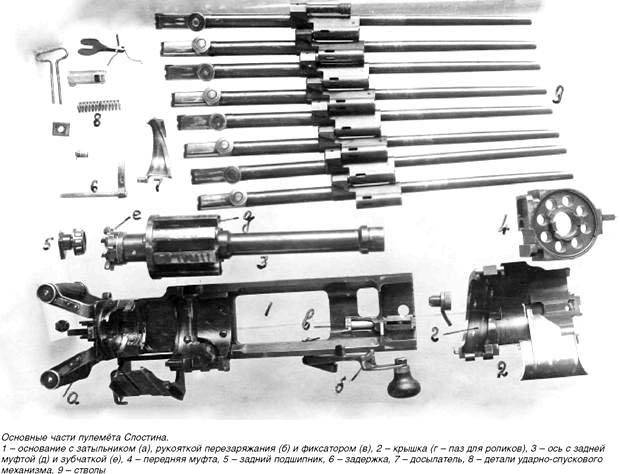
Details of weapons. Photo Oruzhie.info
The new machine gun was noticeably different from the previous one. The designer retained a block of eight trunks of the 7,62 mm caliber, but changed its architecture. Now there was a gas block in the central part of each barrel: on one side there was an L-shaped piston with an internal gas exhaust channel, on the other - a cylindrical gas chamber. With their help, the trunks had to be connected to each other. The piston of one barrel entered the chamber of the next. Near the breech of each trunk there was a thorn with a roller. The trunks were fixed in a pair of couplings, which allowed them to rotate around the longitudinal axis, as well as move along it.
The barrel assembly was mounted on a machine gun with the help of an axis with bearings and female clips. The rear cage had a complex shape and an internal groove for the barrel rollers. It was she who was responsible for the longitudinal movement of the barrels during the shooting. Under the block of trunks, there was a manual reloading mechanism with a cocking handle.
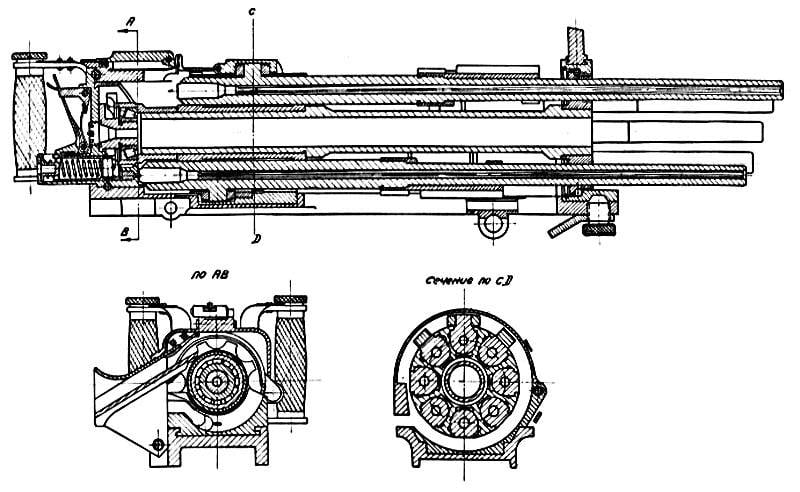
Product Scheme arr. 1946 d. Figure Otvaga2004.ru
The rear gun unit contained a tape ammunition system and firing mechanism. Inside the unit there was a fixed part with shutter functions. The machine gun was supposed to take the metal band on the right; sleeves and links were thrown through the pipe on the left. Pulling the ribbon carried gears associated with the block trunks. The cartridges moved in a circle from right to left and from top to bottom, reaching the disilanement line with a wedge-shaped pusher. The same axis-based system was responsible for cocking the spring-loaded drummer, which was locked in the cocked position with a trigger.
To execute the first shot, it was necessary to place the tape in the receiver and turn the cocking handle. At the same time, the block of trunks was turned, and the power supply system pushed the cartridge to the dismounting line. Then the lower barrel moved back, putting on the cartridge, and carried out the platoon trigger. When you press the trigger, the firing pin was released and fired.
Powder gases from the channel of the “active” barrel through the channel in the piston fell into the chamber of the neighboring barrel. Gases forced the camera along with the barrel to move forward. The roller of this barrel was moved along the copy groove, the shape of which made the whole block of barrels turn. When the block was shifted to 1 / 8 a full turn, the next barrel could fire a shot. At the same time, the liner was extracted from the shot person. The rotation of the barrel block made the ammunition system work and cocked the trigger.
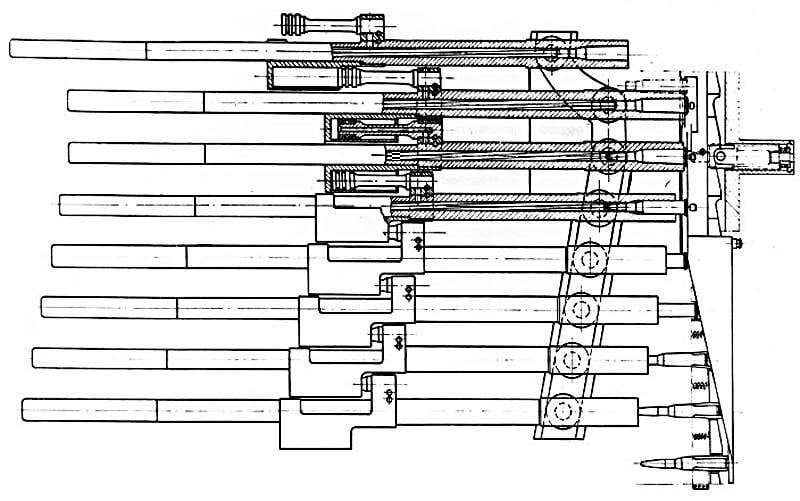
Mechanisms machine gun 1946 g. In the "expanded" form. Figure Otvaga2004.ru
Machine gun Slostin arr. 1946 g. Had a length of 775 mm with a barrel length of 605 mm (stroke length - 50 mm). Own weight of the machine gun - 28 kg (of which 17,2 kg - a rotating unit). When using the Sokolov machine, the weight of the gun reached 67 kg. Calculated rate of fire - 3000-3100 rds / min. Effective range of fire - 2 km.
Tests and recommendations
In the summer of 1946, the improved squall machine gun was sent for testing. The results of the checks were again mixed. The military highly appreciated the original design and made some suggestions. At the same time, the machine gun showed insufficient tactical and technical characteristics, which is why it could hardly be expected to be adopted.
The actual rate of fire was one-third lower than the stated one - no more than 2100 rds / min. This gave a high firepower, but led to an increased consumption of ammunition. The accuracy was 6-7 times lower than that of the SG-43 serial single-barreled machine gun. However, the achieved accuracy in combination with the rate of fire gave the machine gun advantages over all existing samples.
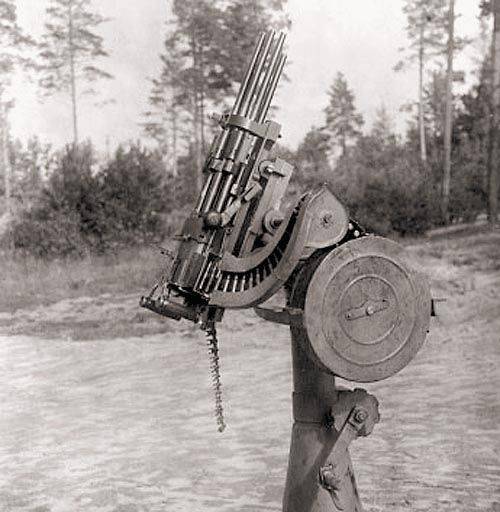
The machine gun Slostina on the cabinet for anti-aircraft shooting. Photo Oruzhie.info
The new machine gun Slostina had no tendency to overheat. Without additional cooling it was possible to do up to 1500 shots. An important feature of the machine gun was ease of operation and the absence of small parts. A distinctive noise was a useful feature of the machine gun. It was stated that it "depressing effect on the nervous system."
Machine gun I.I. Slostina arr. 1946 was considered a good model, able to find its place in the army. It was too heavy for infantry, but it could be used on vehicles. With a suitable carrier, the presence of ribbons on 500 cartridges or more and proper use of such a machine gun could significantly increase the combat capability of the troops.

14.5-mm version of the machine gun, left view. Photos Otvaga2004.ru
However, despite positive test results and high marks, the Slostin machine gun was not recommended for immediate use. At that time, the army already had machine guns with the desired characteristics, and no one began to promote a fundamentally new model.
Heavy squall
During the tests, 1946, a proposal to create a new version of the machine gun I.I. Slostina under another cartridge. It was proposed to develop a product for ammunition 14,5x114 mm. Such a machine gun could strengthen armored vehicles, as well as find use in air defense. The development of such a project again took several years. His trials began in May 1949.
I.I. Slostina had to rework the automation. This time he abandoned the system with cameras and pistons on moving shafts. Now the trunks remained motionless, gas chambers were located on them. Next to the trunks appeared pistons, sliders with rollers to interact with a copy groove. The general principles of rotation of the block of trunks remained the same, but instead of moving trunks, sliders were now used.

View from the other side. Photos Otvaga2004.ru
An enlarged and heavier machine gun for a more powerful cartridge was tested at the test site, during which it demonstrated a number of flaws. It turned out that the block of trunks has too much mass and inertia. As a result, at the time of triggering the USM, the “active” trunk could be in a non-optimal position, and this led to an off-center pinning of the capsule. The absence of a fully-fledged shutter with locking did not ensure the sealing of the chamber. As a result, transverse liner cliffs occurred.
Direct borrowing of developments from the previous project with a change in some nodes led to undesirable results. The main problems squall machine gun arr. 1949 g. Caused by a combination of design and excessive power of the cartridge. To get rid of the identified problems, cardinal processing of the structure was required. She was considered inappropriate, and all work was stopped.
Ahead of time
In 1949, all the work on the Slostin machine guns was stopped. The designer returned to other projects, and the prototypes went to storage, including museums. The promising concept of a multi-frame system has faded into the background. Gunsmiths and gunners continued to develop well-developed architecture.
Later, engineers again faced the issue of increasing the rate of fire, and a new stage of development of multi-barreled systems began in the sixties, including with a rotating block of barrels. A number of similar models were adopted, such systems have found application in various fields. Was the experience taken into account by I.I. Slostina when creating a new weapon is not known for certain. However, it was this gunsmith from Kovrov who was the first in our country to take up a promising direction.
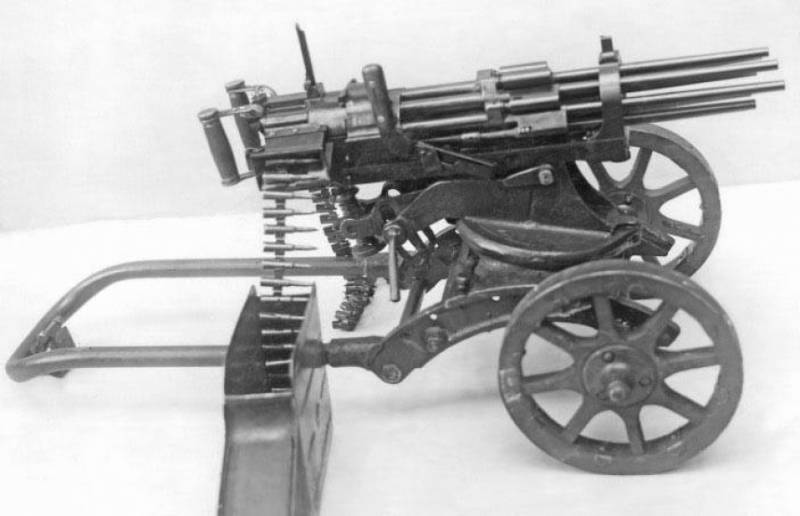
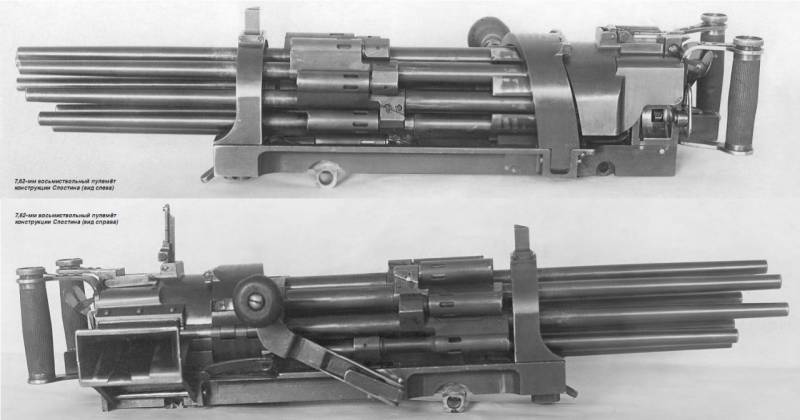
Information